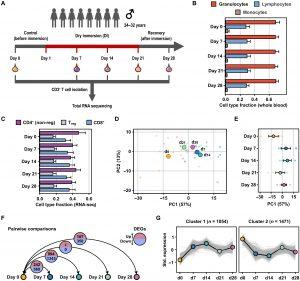In a recent study, researchers described the effects of weightlessness on T cells, a critical component of the immune system (Figure 1). Their findings shed light on the potential reasons behind the decreased activity and effectiveness of astronauts’ T cells in combating infections during space missions.

Figure 1: DI exposure induces transcriptome changes in eight volunteers. (A) Schematic representation describes the experimental procedure. Blood was taken from eight healthy volunteers at five time points: 7 days before DI exposure (day 0, orange); 7 (blue), 14 (teal), and 21 (green) days during DI exposure; and 7 days after DI exposure (day 28, pink). CD3+ T cells were isolated from the blood, and bulk RNA-seq was performed. (B) Horizontal bars show the fraction of granulocytes, lymphocytes, and monocytes in blood isolates before CD3+ T cell isolation as determined by flow cytometry. Values are indicated as means + 1.96 × SEM. (C) Horizontal bars display the estimated fraction of T cell populations detectable in the bulk RNA-seq data as determined by deconvolution analysis with the quanTIseq algorithm. Values are indicated as means + 1.96 × SEM. (D) Factorial map of the PC analysis separates bulk RNA-seq gene expression data of each individual volunteers (small dots) and mean values across all volunteers (large dots). The proportion of variance explained by each PC is indicated in parentheses. Color-coding is according to the different time points. (E) The dot plot shows PC1 separation of bulk RNA-seq samples by time point. Individual values (small dots) and mean values (large dots) are shown per time point (color-coded). Error bars indicate means ± 1.96 × SEM. (F) Illustration displays differentially expressed genes (DEGs) identified by pairwise time point comparisons using DESeq2. The number of significantly (adjusted P < 0.01) up- [positive log2 FC (fold change), red] and down-regulated (negative log2 FC, blue) genes is indicated. (G) Line charts show the two k-means clusters and number of differentially expressed genes per cluster detected in at least one time point comparison. Standardized gene expression profiles for individual genes (gray lines) and the cluster center (connected dots) are shown.
To simulate the weightlessness experienced in space, the researchers utilized a unique method known as dry immersion. This technique involves a specially designed waterbed that tricks the body into perceiving a weightless state. Over three weeks, they closely monitored the T cells in the blood of eight healthy participants during simulated weightlessness.
The results were striking, revealing significant changes in the gene expression of T cells. These T cells began to resemble “naïve” T cells, which are essentially immune cells that haven’t encountered any threats yet. This alteration suggests that these T cells might take longer to activate and, consequently, become less efficient at defending against infections and cancer cells.
The implications of this research are far-reaching, potentially paving the way for novel treatments aimed at reversing these genetic changes in immune cells. By better understanding how weightlessness affects the immune system, we can work towards safeguarding the health of astronauts on future space missions.
Journal article: C.J., Gallardo-Dodd, et al., 2023. Exposure of volunteers to microgravity by dry immersion bed over 21 days results in gene expression changes and adaptation of T cells. Science Advances.
Summary by Stefan Botha










